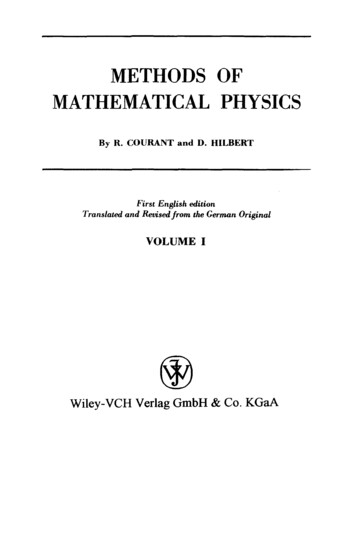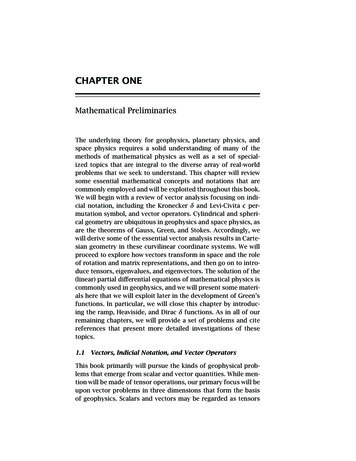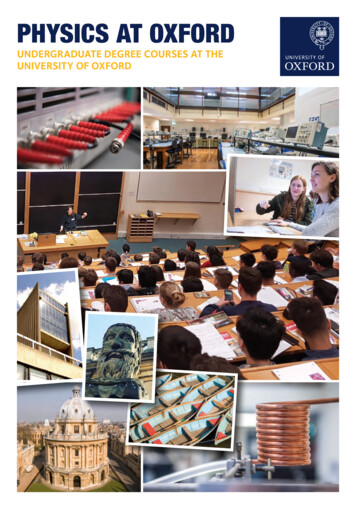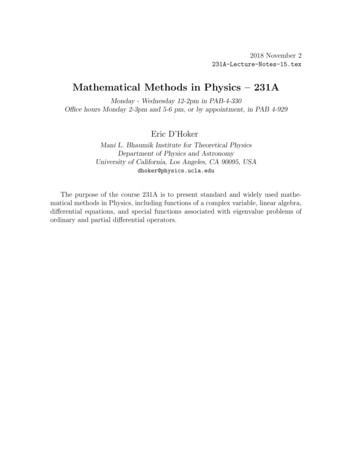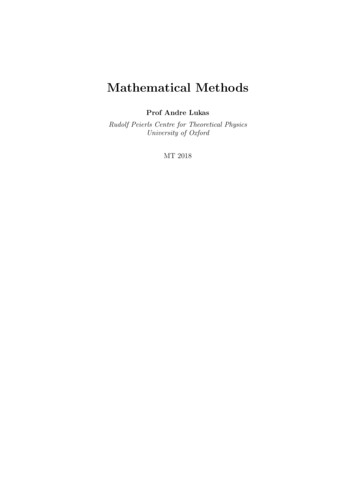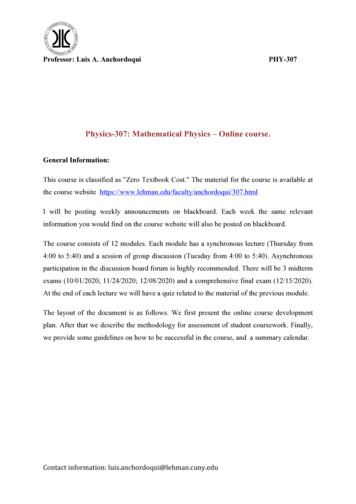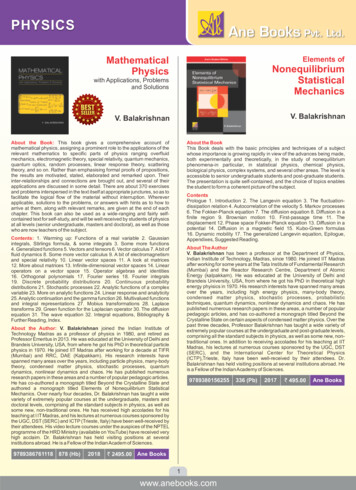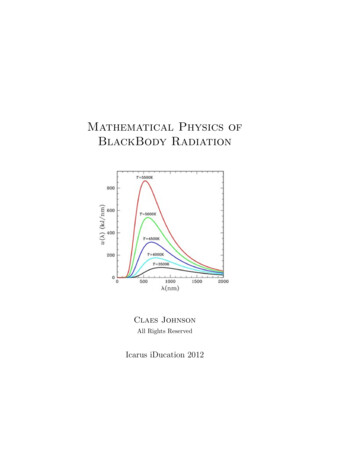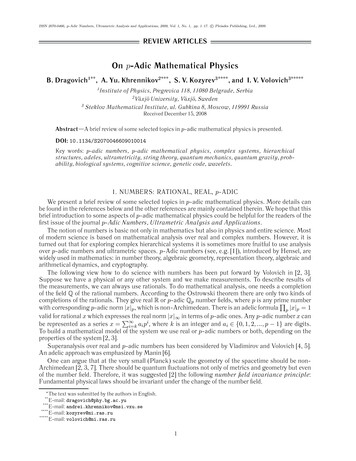
Transcription
c Pleiades Publishing, Ltd., 2009.ISSN 2070-0466, p-Adic Numbers, Ultrametric Analysis and Applications, 2009, Vol. 1, No. 1, pp. 1–17. REVIEW ARTICLESOn p-Adic Mathematical PhysicsB. Dragovich1** , A. Yu. Khrennikov2*** , S. V. Kozyrev3**** , and I. V. Volovich3*****1Institute of Physics, Pregrevica 118, 11080 Belgrade, Serbia2Växjö University, Växjö, Sweden3Steklov Mathematical Institute, ul. Gubkina 8, Moscow, 119991 RussiaReceived December 15, 2008Abstract—A brief review of some selected topics in p-adic mathematical physics is presented.DOI: 10.1134/S2070046609010014Key words: p-adic numbers, p-adic mathematical physics, complex systems, hierarchicalstructures, adeles, ultrametricity, string theory, quantum mechanics, quantum gravity, probability, biological systems, cognitive science, genetic code, wavelets.1. NUMBERS: RATIONAL, REAL, p-ADICWe present a brief review of some selected topics in p-adic mathematical physics. More details canbe found in the references below and the other references are mainly contained therein. We hope that thisbrief introduction to some aspects of p-adic mathematical physics could be helpful for the readers of thefirst issue of the journal p-Adic Numbers, Ultrametric Analysis and Applications.The notion of numbers is basic not only in mathematics but also in physics and entire science. Mostof modern science is based on mathematical analysis over real and complex numbers. However, it isturned out that for exploring complex hierarchical systems it is sometimes more fruitful to use analysisover p-adic numbers and ultrametric spaces. p-Adic numbers (see, e.g. [1]), introduced by Hensel, arewidely used in mathematics: in number theory, algebraic geometry, representation theory, algebraic andarithmetical dynamics, and cryptography.The following view how to do science with numbers has been put forward by Volovich in [2, 3].Suppose we have a physical or any other system and we make measurements. To describe results ofthe measurements, we can always use rationals. To do mathematical analysis, one needs a completionof the field Q of the rational numbers. According to the Ostrowski theorem there are only two kinds ofcompletions of the rationals. They give real R or p-adic Qp number fields, where p is any prime numberwith corresponding p-adic norm x p , which is non-Archimedean. There is an adelic formula p x p 1valid for rational x which expressesnorm x in terms of p-adic ones. Any p-adic number x can the reali , where k is an integer and a {0, 1, 2, ., p 1} are digits.apbe represented as a series x ii k iTo build a mathematical model of the system we use real or p-adic numbers or both, depending on theproperties of the system [2, 3].Superanalysis over real and p-adic numbers has been considered by Vladimirov and Volovich [4, 5].An adelic approach was emphasized by Manin [6].One can argue that at the very small (Planck) scale the geometry of the spacetime should be nonArchimedean [2, 3, 7]. There should be quantum fluctuations not only of metrics and geometry but evenof the number field. Therefore, it was suggested [2] the following number field invariance principle:Fundamental physical laws should be invariant under the change of the number field. The text was submitted by the authors in English.E-mail: dragovich@phy.bg.ac.yu***E-mail: andrei.khrennikov@msi.vxu.se****E-mail: kozyrev@mi.ras.ru*****E-mail: volovich@mi.ras.ru**1
2DRAGOVICH, KHRENNIKOV, KOZYREV, VOLOVICHOne could start from the ring of integers or the Grothendieck schemes. Then rational, real or p-adicnumbers should appear through a mechanism of number field symmetry breaking, similar to the Higgsmechanism [8, 9].Recently (for a review, see [10–14]) there have been exciting achievements exploring p-adic, adelicand ultrametric structures in various models of physics: from the spacetime geometry at small scaleand strings, via spin glasses and other complex systems, to the universe as a whole. There has beenalso significant progress in non-Archimedean modeling of some biological, cognitive, information andstochastic phenomena.Ultrametricity seems to be a generic property of complex systems which contain hierarchy. Moreover,there is some evidence towards much more wide applicability of p-adic and non-Archimedean methodsto various fields of knowledge. To extend p-adic methods into actual problems in diverse fields ofeconomics, medicine, psychology, sociology, control theory, as well as to many other branches ofsciences, is a great challenge and a great opportunity.2. p-ADIC STRINGSString theory is a modern unified theory of elementary particles [15].p-Adic string theories with p-adic valued and also with complex valued amplitudes were suggestedby Volovich in [2, 3]. These two possibilities are in correspondence with two forms of the dual stringamplitude mentioned in [2]. The first one uses the Veneziano amplitude, which describes scattering ofelementary particles, in the formA(a, b) Γ(a) Γ(b),Γ(a b)where a and b are parameters depending on momenta of colliding particles. As a p-adic Venezianoamplitude it was suggestedAp (a, b) Γp (a) Γp (b),Γp (a b)where Γp is the p-adic valued Morita gamma function. The second one uses the following form of theVeneziano amplitude 1xa 1 (1 x)b 1 dx.A(a, b) 0Since the function xa is a multiplicative character on the real axis we can interpret the Venezianoamplitude as the convolution of two characters. In [2] an analogue of the crossing symmetricVeneziano amplitude on the Galois field Fp is also introduced as the convolution of the correspondingcomplex-valued characters, which is the Jacobi sum, χa (x) χb (1 x).A(a, b) x FpFreund and Olson [16] introduced an analogue of the crossing symmetric Veneziano amplitude onthe Qp as the convolution of the corresponding complex-valued characters, which is the Gel’fand-Graevbeta function [17], χa (x) χb (1 x) dx.A(a, b) QpFrampton and Okada [18], and Brekke, Freund, Olson and Witten [19] have discovered that stringamplitudes given by the above formula and its generalization can be described by nonlocal effective fieldtheories. Important adelic formulas were considered by Freund and Witten [20], see also [21]. Vladimirovfound a unified approach to adelic formulas for the superstring amplitudes using algebraic extensions [22]of the number fields [23] (see also [24–26]).Loop corrections to the p-adic string amplitudes are considered in [27, 28]p-ADIC NUMBERS, ULTRAMETRIC ANALYSIS AND APPLICATIONSVol. 1 No. 1 2009
p-ADIC MATHEMATICAL PHYSICS3More information on p-adic string theory see in [10, 12, 29–31].Strings, motives and L-functions are discussed by Volovich [32]. String partition function can beexpressed as inverse to the Mellin transform of L-function of the Deligne motive, τ (n)n s ,L(s) nwhere τ (n) is the Ramanujan function.Motives and quantum fields are discussed by Connes and Marcolli [33]. Motives, algebraic andnoncommutative geometry are explored in [34–38]. Theory of motives is considered by Voevodsky [39].p-Adic geometry is dicsussed in [40].3. p-ADIC FIELD THEORIESAs a free action in p-adic field theory one can take the following functional f Df dxS(f ) Qpwhere f f (x) is a function f : Qp R, dx is the Haar measure and D is the Vladimirov operator or itsgeneralizations [13]. A p-adic analog of the Euclidean quantum field theory was introduced by Kochubeiand Sait-Ametov [41].Renormalizations in p-adic field theory are studied by Missarov [42] and Smirnov [43].Nonlocal scalar field theory [18, 19] for p-adic strings has occurred to be very instructive toymodel [44, 45] for truncated string field theory models [46]. Boundary value problems for homogeneoussolutions of nonlinear equations of motion corresponding to the p-adic string [18, 19],e Φ Φpand its generalizations were explored in [48–52] (here is the d’Alembert operator, the field Φ and itsargument are real-valued). A truncated version of the supersting field theory describing non-BPS branes[47]( 1)e Φ Φ3was investigated in [48, 50, 53, 54].A generalization of these nonlocal models to the case of curved spacetime has been proposed byAref’eva [55] and their application to cosmology, in particular, to the inflation and dark energy wasinitiated. Cosmological applications have been studied in numerous papers [56–67].Quantization of the Riemann zeta-function and applications to cosmology are considered in [68].If ζ(s) is the Riemann zeta-function then the quantum zeta function is the pseudodifferential operatorζ( ), i.e. the Riemann zeta-function is the symbol of the pseudodifferential operator ζ( ). Quantizationof the Langlands program is also indicated.There is a recent consideration towards an effective Lagrangian for adelic strings with the Riemannzeta function nonlocality [69].Zeta-functions and many other areas of mathematics are considered by Shai Haran in [70].A dual connection between p-adic analysis and noncommutative geometry was pointed out byAref’eva and Volovich [71]. It was found that the Haar measure on quantum group SUq (2) is equivalentto the Haar measure on p-adic line Qp if q 1/p.Relation between the space of coherent states for free annihilation operators and the space of p–adicdistributions was found in [72].Physics, number theory, and noncommutative geometry are discussed by Connes and Marcolli[73, 74].The number field invariance principle [2] requires consideration of quantum field theory on an arbitrarynumber field. Such consideration is attempted in [75].p-ADIC NUMBERS, ULTRAMETRIC ANALYSIS AND APPLICATIONSVol. 1 No. 1 2009
4DRAGOVICH, KHRENNIKOV, KOZYREV, VOLOVICH4. p-ADIC AND ADELIC QUANTUM MECHANICSA general modern approach to quantum theory is presented in the Varadarajan book [76]. There areseveral versions of p-adic quantum mechanics. One formulation with the complex valued wave functionsgiven by Vladimirov, Volovich and Zelenov [77, 78] is based on the triple {L2 (Qp ), W (z), U (t)}, whereW (z) is a unitary representation of the Heisenberg-Weyl group in the Hilbert space L2 (Qp ) and U (t) isa unitary dynamics. Representation of canonical commutation relations for p-adic quantum mechanicsfor finite and infinite dimensional systems were studied by Zelenov [79]. Representation theory of p-adicgroups is discussed in [17, 80–82].An approach to a unified p-adic and real theory of commutation relations is developed by Zelenov[83]. It is based on the interpretation of the group of functions with values in the field of rational numbersas the experiment data space.The consequences for particle classification of the hypothesis that spacetime geometry is nonarchimedean at the Planck scale are explored by Varadarajan [84]. The multiplier groups and universaltopological central extensions of the p-adic Poincaré and Galilean groups are determined.p-Adic Maslov index was constructed by Zelenov [85].Another formulation [86] uses pseudodifferential operators and spectral theory. The free wave functionof p-adic quantum mechanics satisfies a pseudodifferential equation of Schrödinger type. A theory of theCauchy problem for this equation is developed by Kochubei [13, 87] and Zuniga-Galindo [88]. Matrixvalued Schrödinger operator on local fields is considered in [89].Adelic quantum mechanics, which is a generalization of p-adic and ordinary quantum mechanics aswell as their unification, was introduced by Dragovich [90]. It was found that adelic harmonic oscillatoris related to the Riemann zeta function [91]. Many adelic physical systems have been considered (as areview, see [92]). As a result of adelic approach and p-adic effects, there is some discreteness of spaceand time in adelic systems [93]. Distributions on adeles are considered by Dragovich [94], E. M. Radynaand Ya. V. Radyno [95].p-Adic path (functional) integrals are considered by Parisi [96], Zelenov [97], Varadarajan [98],Smolyanov and Shamarov [99]. Dragovich [90, 100] introduced adelic path integral and elaboratedit with Djordjević and Nešić [101]. Using path integral approach, the probability amplitude for onedimensional p-adic quantum-mechanical systems with quadratic Lagrangians was calculated in theexact form, which is the same as that one in ordinary quantum mechanics [102]. p-Adic Airy integralsare considered in [103].p-Adic quantum mechanics with p-adic valued wave functions is reviewed below.5. p-ADIC AND ADELIC GRAVITY AND COSMOLOGYp-Adic gravity and the wave function of the Universe are considered by Aref’eva, Dragovich,Frampton and Volovich [104]. In particular, p-adic Einstein equationsRμν 1Rgμν κ Tμν Λ gμν2are explored, where gμν is p-adic valued gravitational field. Summation on algebraic varieties and adelicproducts in quantum gravity are investigated.Adelic quantum cosmology, as an application of adelic quantum mechanics to minisuperspacecosmological models of the very early universe, is initiated by Dragovich [100, 105] and developmentsare presented in [106, 107]. It is illustrated by a few cosmological models, and some discreteness of theminisuperspace and the cosmological constant are found.As was mentioned above, nonlocal scalar field theories for p-adic strings have occurred to beinteresting in cosmology, in particular, in the context of their relation with nonlocal string field inspiredmodels [55–67].p-ADIC NUMBERS, ULTRAMETRIC ANALYSIS AND APPLICATIONSVol. 1 No. 1 2009
p-ADIC MATHEMATICAL PHYSICS56. p-ADIC STOCHASTIC PROCESSESThe p-adic diffusion (heat) equation f (x, t) Dxα f (x, t) 0 twas suggested in [10], and its mathematical properties and properties of the associated stochasticprocesses were studied (see also [98, 108–110]). Here f f (x, t) is a real valued function of the realtime t and the p–adic coordinate x. Dxα is the Vladimirov operator.p-Adic Brownian motion is explored in [111–113], see also [114]. Various classes of p-adic stochasticprocesses are investigated by Albeverio and Karwowski [115], Kochubei [13], Yasuda [116], Albeverioand Belopolskaya [117]; see [13] for further references. For the most recent results on p-adic stochasticintegrals and stochastic differential equations see [118].Kaneko [119] showed a relationship between Besov space and potential space, and pointed out aprobabilistic significance of the relationship in terms of fractal analysis.7. VLADIMIROV OPERATORThe Vladimirov operator [10, 120] of p-adic fractional differentiation is defined as αα χ( kx) k p dkf (k)dk,f (k) χ(kx)f (x)dx.D f (x) QpQpHere f (x) is a complex-valued function of p-adic argument x and χ is the additive character: χ(x) exp (2πi{x}), {x} is the fractional part of x.For α 0 the Vladimirov operator has the following integral representation 1f (x) f (y)αdy,D f (x) Γp ( α) Qp x y 1 αpwith the constantΓp ( α) pα 1.1 p 1 αThere is a well-developed theory of the Vladimirov operator and related constructions (spectralproperties, operators on bounded regions, analogs of elliptic and parabolic equations, a wave-typeequation etc); see section on wavelets and [10, 13, 121–123].8. DYNAMICS AND EVOLUTION OF COMPLEX BIOLOGICAL SYSTEMSAn idea of using ultrametric spaces to describe the states of complex biological systems, naturallypossess a hierarchical organization, has been sound more than once as from the middle of the 1980th byG. Frauenfelder, G. Parisi, D. Stain, and the others, see [124]. In protein physics, it is regarded as one ofthe most profound ideas put forward to explain the nature of distinctive life attributes, since it proposes,in a wide extend, the existence of very peculiar order inherent the information and functional carriers inbiology.In earlier theoretical examination of this idea, some models of ultrametric random walk wereproposed, but they were confronted with difficulties in applications to the protein fluctuation dynamics,in particular, to the large body of data obtained in the experiments on ligand-rebinding kinetics ofmyoglobin and spectral diffusion in deeply frozen proteins.Realization of this task has been provided for last years by V. Avetisov in collaboration with A. Bikulov,S. Kozyrev, V. Osipov, and A. Zubarev [125–129]. It was shown that, in spite of extreme complexity ofthe protein energy landscape, p-adic diffusion equation introduced in [10] offers a surprisingly simple,accurate, and universal description of the protein fluctuation dynamics on extremely large range of scalesfrom cryogenic up to room temperatures: f (x, t) Dxα f (x, t) 0, tα p-ADIC NUMBERS, ULTRAMETRIC ANALYSIS AND APPLICATIONS1.TVol. 1 No. 1 2009
6DRAGOVICH, KHRENNIKOV, KOZYREV, VOLOVICHHere t is the real time and the p-adic coordinate x describes the “tree of basins” which corresponds tothe conformational state of the protein, T is the temperature. This equation was used to describe twodrastically different types of experiments — on rebinding of CO to myoglobin and spectral diffusion ofproteins.These applications of p-adic diffusion equation to the protein dynamics highlight very importantprotein attribute, namely, the fact that protein dynamic states and protein energy landscape, being bothextremely complex, exhibit the hierarchical self-similarity.On the opposite side of biological complexity, e.g. in modeling of optimization selection of complexbiological entities over combinatorial large evolutionary spaces, the p-adic stochastic processes haverecently been recognized as a useful tool too. Though the fact of natural ultrametric (taxonomic)relationships in biology, the ultrametric representation of biological realm has not been reflected bymodels.Such an evolutionary model, based on p-adic diffusion equation, has recently been proposed byV. Avetisov and Yu. Zhuravlev [130]. It is interesting, that the model, being suggested to describethe evolution of complex biological entities, cast light on the basic point of the prebiotic evolutionaryconcepts known as the “error catastrophe”. It was found that the prebiotic evolution can be gettingbeyond the continuity principle of Darwinian evolutionary paradigm.9. QUANTIZATION WITH p-ADIC VALUED WAVE FUNCTIONSThe first step toward quantum mechanics with wave functions valued in non-Archimedean fields(and even superalgebras) was done by Vladimirov and Volovich [4, 5], see also [3]. This approach waselaborated by Khrennikov in series of papers and books [131–134], [11] and extended in collaborationwith Cianci and Albeverio [135–137, 147, 148]. Here we present essentials of this theory. The basicobjects of this theory are the p-adic Hilbert space and symmetric operators acting in this space[149, 150]. Vectors of the p-adic Hilbert space which are normalized with respect to inner productrepresent quantum states. p-Adic valued quantum theory suffers of the absence of a “good spectraltheorem”. At the same time this theory is essentially simpler (mathematically), since operators ofposition and momentum are bounded. Thus the canonical commutation relations can be representedby bounded operators1 . It is impossible in the complex case. Representations of groups in Hilbert spacesare cornerstones of quantum mechanics. In [135] Albeverio and Khrennikov constructed a representationof the Weyl–Heisenberg group in the p-adic Hilbert space. Spectra of the position and momentumoperators were studied in [136], [137].Theory of p-adic valued functions is exposed in the Schikhof book [138]. Spectral theory in ultrametric Banach algebras and the ultrametric functional calculus are considered by Escassut [139], analyticfunctions on infraconnected sets are studied in [140]. Theory of meromorphic functions over nonArchimedean fields is presented by Pei-Chu Hu and Chung-Chun Yang [141]. Differential equationsfor p-adic valued functions were studied by many authors, see [142, 143]. p-Adic summability ofperturbation series is also investigated, see [144–146].10. Qp -VALUED PROBABILITYThis quantum model induces Qp -valued “probabilities”. Surprisingly we can proceed in the rigorousprobabilistic framework even in such unusual situation – including limit theorems and theory ofrandomness, see Khrennikov [11, 134, 147, 148]. The starting point of such a generalized probabilisticmodel was extension of von Mises’ frequency probability theory to p-adic topologies: frequencies ofrealizations should stabilize not with respect to the ordinary real topology, but one of p-adic topologies.We emphasize that relative frequency is always a rational number: νn (α) n(α)/N, where N is the totalnumber measurements and n is the number of realizations favorable to the fixed result α. In the simplestcase α 0, 1. Thus the p-adic version of frequency probability theory describes a new class of randomsequences, a new type of randomness.1It was discovered by Albeverio and Khrennikov [135] and later and independently by Kochubei [151] (with a differentconstruction of the representation), see also Keller, Ochsenius, and Schikhof [152].p-ADIC NUMBERS, ULTRAMETRIC ANALYSIS AND APPLICATIONSVol. 1 No. 1 2009
p-ADIC MATHEMATICAL PHYSICS711. APPLICATIONS TO COGNITIVE SCIENCE AND PSYCHOLOGYThe idea of encoding mental states by numbers has very long history – Plato, Aristotle, Leibnitz,and the others. A new realization of this idea was provided by Khrennikov who used rings of m-adicnumbers ZZm to encode states of the brain, see [147]. This approach was developed in collaborationwith Albeverio, Kloeden, Tirozzi, Gundlach, Dubischar, Steinkamp [153–163], [148]. The model of madic (and more general ultrametric) mental space was applied to cognitive science and psychology,including modeling of coupling between unconscious and conscious flows of information in the brain.Coupling with neurophysiology was studied in [162, 163] – the process of “production” of m-adic mentalspace by neuronal trees. This model can be used for description of arbitrary flows of information on thebasis of m-adic information space. The main distinguishing feature of this approach is a possibility toencode hierarchical structures which are present in information by using ultrametric topologies, treelikestructures. Ultrametric algorithmic information is considered by Murtagh [164].12. APPLICATIONS TO IMAGE ANALYSISPractically all images have (often hidden) hierarchical structures. These structures can be represented by using m-adic information spaces. In some cases the m-adic representation of imagesessentially simplifies analysis, in particular, image recognition. One can ignore details which belongto lower levels of the m-adic hierarchy of an image. More effective algorithms can be developed startingwith the m-adic encoding of information. This approach was developed by Benois-Pineau, Khrennikov,Kotovich, and Borzistaya [165–167].13. p-ADIC WAVELETSp-Adic wavelet theory was initiated by Kozyrev [168]. Since in the p-adic case it is not possibleto use for construction of wavelet basis translations by elements of Z, it was proposed to use insteadtranslations by elements of the factor group Qp /Zp . An example of p-adic wavelet was introduced in theform of the product of the character and the characteristic function Ω of the unit ball:ψ(x) χ(p 1 x)Ω( x p ).The orthonormal basis {ψγnj } of p-adic wavelets in L2 (Qp ) was constructed [168] by translations anddilations of ψ:γψγnj (x) p 2 χ(pγ 1 j(x p γ n))Ω( pγ x n p ),γ Z,n 1 nl pl Qp /Zp ,nl 0, . . . , p 1,j 1, . . . , p 1.l kIn p-adic analysis wavelet bases are related to the spectral theory of pseudodifferential operators. Inparticular, the above p-adic wavelets are eigenvectors of the Vladimirov operator:Dα ψγnj pα(1 γ) ψγnj .Spectra of more general operators were studied in [169].Moreover, the orbit of the wavelet ψ with respect to the action of the p-adic affine group x b 1,a, b Qp , a 0,G(a, b)f (x) a p 2 fagives the set of products of p-adic wavelets from the basis {ψγnj } and roots of one of the degree p.In general [170], the orbit of generic complex-valued locally constant mean zero compactly supportedfunction gives a frame of p-adic wavelets.Relation between real and p-adic wavelets is given by the p-adic change of variable: the mapρ : Qp R ,ρ: i γxi pi xi p i 1 ,xi 0, . . . , p 1,γ Zi γp-ADIC NUMBERS, ULTRAMETRIC ANALYSIS AND APPLICATIONSVol. 1 No. 1 2009
8DRAGOVICH, KHRENNIKOV, KOZYREV, VOLOVICHmaps (for p 2) the basis {ψγnj } of p-adic wavelets onto the basis of Haar wavelets on the positivehalf–line.Important contributions in p-adic wavelet theory were done by Albeverio, Benedetto, Khrennikov,Shelkovich, Skopina [171–176]. p-Adic Tauberian and Shannon-Kotelnikov theorems were investigated by Khrennikov and Shelkovich [177].14. ANALYSIS ON GENERAL ULTRAMETRIC SPACESThe analysis of wavelets and pseudodifferential operators on general locally compact ultrametricspaces was developed in [14, 178–180]. A pseudodifferential operator on ultrametric space X is definedby Kozyrev as the following integral operator: T (sup(x, y))(f (x) f (y)) dν(y)T f (x) Xwhere ν is a Borel measure and some integrability condition for the integration kernel is satisfied. Thesup(x, y) is the minimal ball in X which contains the both points x and y, i.e. the integration kernel T isa locally constant (for x y) function with the described domains of local constancy.Ultrametric wavelet bases {ΨIj } were introduced and it was found that ultrametric wavelets areeigenvectors of ultrametric pseudodifferential operators:T ΨIj λI ΨIj .Let us note that locally compact ultrametric spaces under consideration are completely general and donot possess any group structure.Analysis on p-adic infinite-dimensional spaces was developed by Kochubei, Kaneko and Yasuda[13, 181–184].Another important class of ultrametric spaces consists of locally compact fields of positive characteristic. Analysis over such fields has both common and different features with p-adic analysis. See thebook of Kochubei [185] for the details.15. CASCADE MODELS OF TURBULENCEOne of the problems of fully developed turbulence is the energy-cascading process. This process ischaracterized by large hierarchy of scales involved and is known as the Richardson cascade. The mainidea of the Fischenko and Zelenov paper [186] was to consider the equation of cascade model not incoordinate space, but in an ultrametric space connected with hierarchy of turbulence eddies. This idealeads to a rather simple nonlinear integral equation for the velocity field.Properties of fully developed turbulence such as multifractal behavior of energy dissipation orKolmogorov’s 1/3 behavior are obtained by analysis of solutions of the nonlinear equation over padic numbers. So, p-adic numbers provide a natural and systematic approach to cascade models ofturbulence.A modification of nonlinear ultrametric integral equation of [186] was investigated in [187] by Kozyrev.It was found [187] that, using the ultrametric wavelet analysis, we get a family of exact solutions forthis modified nonlinear equation. Moreover, for this equation an exact solution of an arbitrary Cauchyproblem with the initial condition in the space of locally constant mean zero compactly supportedfunctions was constructed.p-ADIC NUMBERS, ULTRAMETRIC ANALYSIS AND APPLICATIONSVol. 1 No. 1 2009
p-ADIC MATHEMATICAL PHYSICS916. DISORDERED SYSTEMS AND SPIN GLASSESSpin glasses (disordered magnetics) are typical examples of disordered systems. Order parameter fora spin glass in the replica symmetry breaking approach is described by the Parisi matrix — some specialhierarchical block matrix. It was found that [188] the structure of correlation functions for spin glassesare related to ultrametricity.Avetisov, Bikulov, Kozyrev [125] and Parisi, Sourlas [189] found that the Parisi matrix possessesthe p-adic parametrization, namely matrix elements of this matrix after some natural enumeration ofthe lines and columns of the matrix can be expressed as the real valued function of the p-adic norm ofdifference of the indicesQab q( a b p ).This allows to express the correlation functions of the spin glass in the state with broken replicasymmetry in the form of some p-adic integrals.Also more general replica solutions related to general locally compact ultrametric spaces wereobtained [190–192]. The p-adic Potts model is considered in [193, 194].17. p-ADIC DYNAMICAL SYSTEMSThe theory of p-adic dynamical systems [195] is an intensively developing discipline on the boundarybetween various mathematical theories – dynamical systems, number theory, algebraic geometry, nonArchimedean analysis – and having numerous applications – theoretical physics, cognitive science,cryptography, computer science, automata theory, genetics, numerical analysis and image analysis.One of the sources of theory of p-adic dynamical systems was dynamics in rings of mod pn -residueclasses. We can mention investigations of W. Narkiewicz, A. Batra, P. Morton and P. Patel, J. Silvermanand G. Call, D.K. Arrowsmith, F. Vivaldi and Hatjispyros, J. Lubin, T. Pezda, H-C. Li, L. Hsia, see,e.g., [197], [196] and also books [195], [198] for detailed bibliography. Another flow was induced inalgebraic geometry. This (algebraic geometric) dynamical flow began with article of M. Herman andJ.C. Yoccoz [199] on the problem of small divisors in non-Archimedean fields. It seems that this wasthe first publication on non-Archimedean dynamics. In further development of this dynamical flow thecrucial role was played by J. Silverman, R. Benedetto, J. Rivera-Letelier, C. Favre, J-P. Bézivin, seeSilverman’s book [200] for bibliography.Another flow towards algebraic dynamics has p-adic theoretical physics as its source. One of theauthors of this review used this pathway towards p-adic dynamical systems, from study of quantummodels with Qp -valued functions. As a result, a research group on non-Archimedean dynamics wascreated at the Växjö University, Sweeden: Andrei Khrennikov, Karl-Olof Lindahl, Marcus Nilsson,Robert Nyqvist, and Per-Anders Svensson [195].We point out recent publications of V. Arnold, e.g., [201], dev
p-ADIC MATHEMATICAL PHYSICS 3 More information on p-adic string theory see in [10, 12, 29-31]. Strings, motives and L-functions are discussed by Volovich [32].String partition function can be expressed as inverse to the Mellin transform of L-function of the Deligne motive, L(s) n τ(n)n s, where τ(n)is the Ramanujan function. Motives and quantum fields are discussed by Connes and .

